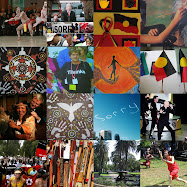
Only
forty years ago, the original inhabitants of Australia, the Aboriginal people, were not counted as people in Australia. A referendum held on May 27, 1967 enabled a change to occur which meant that the Australian Constitution was changed in two ways, so that the Commonwealth government would be able to make laws relating to Aboriginal people*, and allowing Aboriginal people to be counted in the national census* (more about the changes below).
Forty years ago tomorrow, more than 90 per cent of Australians voted in favour of the changes.
One important outcome has been that the referendum has acquired a symbolic meaning in relation to a period of rapid social change during the 1960s.
Many injustices were (and many remain) evident. In 1965, Aboriginal
Freedom Rides were organised, whereby buses of Aboriginal and non-Aboriginal people visited country towns where there were, for example, laws preventing Aboriginal people using local swimming pools.
Throughout white history of Australia, children had been forcibly removed from their families.
Ten years ago, on May 26, 1997, a Human Rights and Equal Opportunity presented the findings of the National Inquiry into the separation of Aboriginal and Torres Strait Islander children from their families - the "stolen generation" - in a report entitled
Bringing Them Home. This part of our history still affects many Aboriginal people today. It is not ancient history, it is part of the experience lived by many able to tell their story today. Many many of the recommendations have never been implemented, including a refusal by the federal government to say "Sorry" (hence the naming of today "Sorry Day"). Others (mainly but not exclusively, non-Aboriginal) argue that such symbolism is now unnecessary - it is all too long ago, and there are other things to get on with; others argue that without truth and acknowledgement of past wrongs, little can be achieved in the future.
In 1991, a Royal Commission into Aboriginal Deaths In Custody presented its report. Many of the recommendations are yet to be properly implemented.
Further information here. On May 28, 2000, more than 250 000 people walked across Sydney Harbour Bridge in support of reconciliation, and more than a million Australians across the country participated in similar marches.
My blog on 26 January this year shows the plaque commemorating the event. And below are my (scanned) photos from that day.
There's a walk and gathering in Sydney today to mark these occasions. Unfortunately I can't attend but above is a copy of an Artist Trading Card I made recently, called 'Hands Up For Reconciliation'.
* The first was a phrase in Section 51 which stated that the Federal Government had the power to make laws with respect to "the people of any race, other than the Aboriginal race in any State, for whom it is deemed necessary to make special laws." (This is known as the "race power.") The referendum removed the phrase "other than the Aboriginal race in any State," giving the Commonwealth the power to make laws specifically to benefit Aboriginal people.
* The second was Section 127, which said: "In reckoning the numbers of the people of the Commonwealth, or of a State or other part of the Commonwealth, Aboriginal natives shall not be counted." The referendum deleted this section from the Constitution.
More info about significant events in Aboriginal history. 


 My Reconciliation Walk photos from 28 May 2000.
My Reconciliation Walk photos from 28 May 2000.
It was amazing being part of such a huge crowd with hope int heir hearts and goodwill. Unfortunately, Aboriginal life expectancy is still 17 years below that of non-Aboriginal Australians, education outcomes are poorer, and infant mortality unacceptable high. Despite the stereotypical image, the majority of Aborigines live in urban and regional, populated areas, not the remote areas of the outback. Most of those Aborigines have long been dispossesed of their land and clan and family identity.





















































